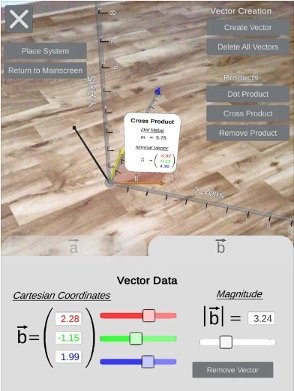Want to Understand How a Vector Works? Now, There’s an App for That!
Spatial intelligence is the capacity to visualize in one’s mind the positions of objects, their shapes, their relations in space to one another and the movement they make to form new spatial relations. This ability to perform spatial reasoning in one’s own head is essential for mastering abstract ideas in STEM (Science, Technology, Engineering and Mathematics) as well as in many artistic areas and other fields.
Research shows that the ability to perform spatial reasoning can be significantly improved with practice and training. So: Could there be an educational tool developed that would truly mirror the real experience?
That was the impetus for an innovative idea by Professor Gerd Krizek of the University of Applied Sciences Technikum Vienna’s Department of Applied Mathematics and Physics to use Augmented Reality (AR) to help people learn to be better spatial reasoners.
The result is the app Vector AR3, the winner of the Mobile Learning category in the 2020 International E-Learning Awards, Academic Division.
Using augmented reality, the Vector AR3 App provides an interactive experience whereby real-world objects are enhanced by accurately rendered computer-generated 3D objects. The app has been designed around the experience of a virtual vector moving in one’s real-world physical space.
The Project
This mobile app, available on iOS and Android mobile phones and tablets, allows for a learner to manually manipulate a virtual vector in their real-life environment, as seen from the eye of the learner’s mobile camera. This “hands-on” experience helps learners “see” how vectors act in a 3D space from various angles, using the app’s guided manipulation tools and programmed calculations. The primary audience for this app is graduate students in engineering studies, though it is also appropriate for undergraduate or even high school level math and science courses.
The tool is designed to teach students how vectors work by bringing an abstract concept (literally) into their own hands. The learn-by-doing, self-directed instructional tool presents information in a step-by-step sequence. It is problem-oriented, allowing students to create and manipulate all types of vectors. This tool also promotes peer-to-peer learning, as students can work together on a shared tablet.
A key feature of this interactive, “hands-on” AR tool is that the learner does not need to visualize a vector in their mind’s eye, or even imagine how a virtual reality (VR) vector moves in space—instead, they can actually interact with a 3D vector in their own real-life environment.
The app is designed to be used by students as a self-directed tool and by university-level and secondary school-level instructors as a teaching tool. A companion instructor tutorial with suggested teaching scenarios is currently in the works.
Screenshot of the Vector AR3 app showing how learners can manipulate vectors and surfaces in 3D space using AR.
The Promise
The decision to create an Augmented Reality (AR) app was a deliberate choice and a challenge; Professor Krizek also views his decision as an invitation to other learning professionals and innovators to follow suit.
Professor Krizek purposely developed the app as an open educational resource (OER) so that it is available to anyone at no charge. He is also hoping that the app’s success—so far, based on positive feedback from users, the app has been very successful—inspires others to use AR to develop other learning tools, particularly in scientific fields. The Vector AR3 app is available to anyone who is interested; it is free (with no advertisements), in English, and compatible with most common operating systems.
I have found that the best way to truly understand this “hands-on” tool is by trying it out. You can download the app for free at:
https://apps.apple.com/us/app/vector-ar3-by-fhtw/id1464507466
https://play.google.com/store/apps/details?id=com.Senselab.io.VektorAR
Vector AR3 by FHTW by SoftVR GmbH
About the author: Evelyn Levine works as a Training and Staff Development Director for the U.S. Courts. She writes on worldwide learning and development trends in public and private sectors. She can be reached at levinee@prodigy.net.


